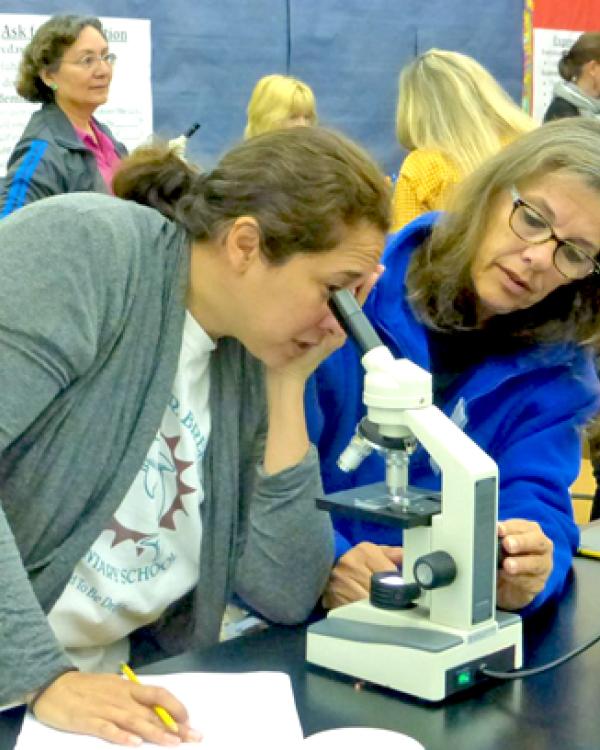
Several of the participants in the week-long science professional development program
UC Santa Barbara’s NSF Center for Sustainable Use of Renewable Feedstocks* and the South Coast Science Project teamed with Science Matters and District Teacher Leaders to produce an intense week of engaging and thought-provoking learning opportunities for 35 1st-6th grade teachers from Santa Barbara and Ventura County. This community of teachers met at Carpinteria Middle School and immersed themselves in the Next Generation Science Standards through hands-on exploration of lessons involving the disciplinary core ideas of Molecules to Organisms and Ecosystems. Teacher leaders worked with UCSB faculty, highlighting lessons that integrated the English Language Arts Common Core Standards and language development for English-language learners with the Next Generation Science Standards.
“[Learning] how to use science content, engagement, and experimentation is key to building oral language and listening as well as reading and writing,” wrote one participant after the event. “By using science, we not only increase rigor in an engaging way but also build equity amongst groups. No other content area does all of these things for students and teachers in this way!”
Dr. Darby Feldwinn, an affiliated faculty member of UC Santa Barbara’s Gevirtz School, led one component of the week’s professional development. Her SciTrek/CenSURF module on Respiration took teachers on a five-day journey of discovery. As one teacher stated, “It was so powerful to experience it from a student’s point of view and to be able to work on a problem over an extended period of time. Also amazing was the teacher leaders modeling both as a scientist, verbalizing scientific thought processes, and as a teacher, modeling how to ask questions to help students think deeper.”
Dr. Feldwinn’s program structure allows students (or in the case of this week, the teachers) to discover the answers for themselves while highlighting the significance and importance of the process. This method showcases a significant shift from the old California Standards of “students will know” to the Next Generation Science Standards approach that “students who demonstrate understanding can.”
Lisa LaMontagne from Earth’s Academy in the Conejo Valley Unified School District commented that one of the week’s many highlights was, “Experiencing the whole scientific process, especially the design and implementation of our own experiment; and the challenge to cite readings and experimental results to back up a concept/claim.”
Lilly Garcia, co-director of the program and Director of STEM Outreach at the Gevirtz School, said, “This week of transformational work was a collaborative effort made possible by the team of faculty and teacher leaders who worked so seamlessly together.” Dr. Susan Johnson, academic coordinator for CalTeach in the Teacher Education Program and Department of Education, believes strongly in the power of distributed leadership. She stated, “The teacher leaders were so essential to the success of the workshop. They brought valued expertise and knowledge of the real world of the classroom to our collaboration.”
Dr. Petra van Koppen of UCSB’s Department of Chemistry and Biochemistry commented, “This work is a collaborative professional development partnership funded by CenSURF,* Science Matters, the South Coast Science Project (SCSP), the RORD Foundation, and the B P Moser Trust. We would like to thank Janet Sands and Paul Cordeiro for their continued support and the Carpinteria Unified School District for hosting the event.”
* The Center for the Sustainable Use of Renewable Feedstocks (CenSURF) headquartered at UCSB is a Center for Chemical Innovation funded by the National Science Foundation.